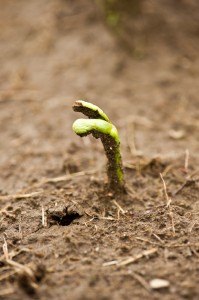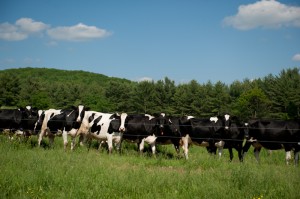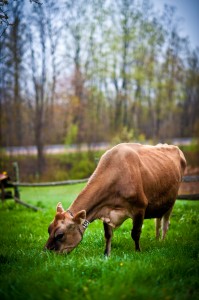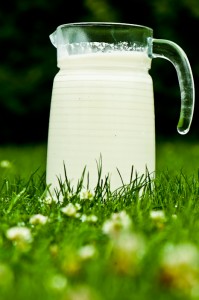Our farming activities and decisions are driven by the questions “What ought we do?” and “How ought we do it?” This is an ethical, moral “ought,” not just an economic “ought,” one which reaches beyond ourselves and our self-interest to wider and wider circles of community. It is the very “ought” which brought me back to farming. The holistic perspective which informs this “ought,” is, I think, the foundation for a broad sustainability and ethical agriculture.
 What this encompasses might be called sustainability or perpetual productivity. Farming practices are sustainable when they maintain, and ideally improve, the fertility and productivity of the land in the long term. Environmentally, this would mean that topsoil and organic matter increase rather than decrease, that water quality and supply improve rather than deteriorate, and that land and water (and in turn living things) are not polluted by toxic chemicals. There also has to be a net energy sustainability, by not using more non-renewable energy (namely, petroleum) than could or is actually be produced by that activity. And the tallies must be broad and holistic—that is, we ought not simply offload the problems with our agriculture onto somebody else’s backyard or nation.
What this encompasses might be called sustainability or perpetual productivity. Farming practices are sustainable when they maintain, and ideally improve, the fertility and productivity of the land in the long term. Environmentally, this would mean that topsoil and organic matter increase rather than decrease, that water quality and supply improve rather than deteriorate, and that land and water (and in turn living things) are not polluted by toxic chemicals. There also has to be a net energy sustainability, by not using more non-renewable energy (namely, petroleum) than could or is actually be produced by that activity. And the tallies must be broad and holistic—that is, we ought not simply offload the problems with our agriculture onto somebody else’s backyard or nation.
Economic and social sustainability matter too. The wages must be fair, the lives of workers and farmers respected, and the integrity of communities, small and large, considered and furthered.
Back to the farm. Now, probably 99% of other dairy farmers would scoff at my self-ascription. We’re currently milking a whopping 2 cows, and hope to bring that number up to (only) 6 or 8 in the coming year. In contrast, the average herd size in New York is 113 cows, and the range of course goes from much smaller to much, much bigger.
 The fact that we decided to go with—or stay with—dairy cattle at all goes back to that encounter I had with Heifer International, and learning about rotational grazing and grass-fed food, and the overarching ethical impetus to my farming.
The fact that we decided to go with—or stay with—dairy cattle at all goes back to that encounter I had with Heifer International, and learning about rotational grazing and grass-fed food, and the overarching ethical impetus to my farming.
A dense, lush pasture sward is an extremely efficient solar harvester, capturing sunlight and transforming it into plant energy, and in turn animal and then human energy. And because there’s a lot of sun-powered plant growth, perennial pastures sequester high amounts of carbon from the atmosphere (rotationally managed pasture is even more carbon-productive than forests!). A meadow is like a huge solar array. But this solar panel can feed people. In terms of productivity, rotationally managed and grazed pasture can compete with row-crops, in such terms as carbon sequestration, human food potential, and economic returns.
 Ruminants, in turn, are highly efficient converters of that plant matter. With a special stomach (the rumen) to digest cellulose, grazers like cattle, sheep, goats, and deer can gain energy from plant matter which monogastric (single-stomach) animals like humans, pigs, and poultry cannot. This means grazers or “grass farmers” can produce food (high-protein food), and in term income, from pastureland. They can do this on land that is not suitable for tillage (for growing row crops like beans or grains, for instance), and/or for less energy use (and in some cases, less erosion, chemical use, and fertility wash-off).
Ruminants, in turn, are highly efficient converters of that plant matter. With a special stomach (the rumen) to digest cellulose, grazers like cattle, sheep, goats, and deer can gain energy from plant matter which monogastric (single-stomach) animals like humans, pigs, and poultry cannot. This means grazers or “grass farmers” can produce food (high-protein food), and in term income, from pastureland. They can do this on land that is not suitable for tillage (for growing row crops like beans or grains, for instance), and/or for less energy use (and in some cases, less erosion, chemical use, and fertility wash-off).
Some of the reasons that managed grazing is so productive is because animals are given access to pasture growth when it is in optimal condition (high in energy and protein), grazed down to a height which leaves the plants growth points as well as some leaf residue. The remaining leaves as well as the plant’s root reserves of carbohydrates allow the plant to reestablish itself, providing new growth and thus new food for grazers in a few weeks to a few months. The mechanics of grazing—biting the higher growth of grass—also encourages more tillering, producing side-shoots and extra leaves to capture more light and carbon. In the long term this creates a full solar pasture-array on the soil surface. Grazing animals also offer the benefit of fertilizing their own food source, by dropping nitrogen-rich urine and manure onto the land they have just grazed from. Furthermore, the mechanical action of their hoofs serves to work plant debris into the soil, for soil life to decompose and increase the organic matter and fertility of the land.
Neither non-rotational-grazing nor mechanical harvesting is as optimal and beneficial. When animals continuously graze pasture (in a non-rotational setting), they are constantly biting off new plant growth, so plants are basically always struggling to survive and are less productive. Moreover, animals will generally eat favored plants and leave less-desirable ones, so overall pasture composition can shift towards less than ideal types and balances of growth patterns, making for less productive pasture overall. Relatedly, when mechanically harvesting grassland (as hay, for instance), not only is non-animal energy and input required, the land is not as productive. The economics generally require that hay is harvested when there is a balance between quality and yield, usually meaning more mature grass is harvested, which is both less nutritious for producing animals, and also that the pasture or sod production has declined as those plants reached maturity. Harvested grass fields also tend to be less dense, and also require more heavy doze fertilizer applications which are more likely to leach into surface water runoff and enter waterways.
 All this is to say it seems a Good Thing to graze animals. Managed grazing of ruminants does good for the health of soil, water, and air, and converts sunlight and carbon into animal food which in turn becomes people food. Healthy people food: I mentioned earlier that grass-fed milk, meat, and eggs are healthier than their conventional, more grain-fed counterparts. The fats in these foods are less saturated, with less cholesterol (and more of the good kind), and with more omega-3 fatty acids in the optimum balanced with Omega-6s. Grass-fed foods also contain more vitamins like A and E, and nutrients conjugated-linoleic acids and beta-carotene—the latter to which the yellow-golden color of grass-fed milk, fat in meats, and egg yolks testifies. Feeding people Good Food grown in a Good Way: what better use of our lands? Hence the foundation in pasture of our farming, the meadows around which all is woven.
All this is to say it seems a Good Thing to graze animals. Managed grazing of ruminants does good for the health of soil, water, and air, and converts sunlight and carbon into animal food which in turn becomes people food. Healthy people food: I mentioned earlier that grass-fed milk, meat, and eggs are healthier than their conventional, more grain-fed counterparts. The fats in these foods are less saturated, with less cholesterol (and more of the good kind), and with more omega-3 fatty acids in the optimum balanced with Omega-6s. Grass-fed foods also contain more vitamins like A and E, and nutrients conjugated-linoleic acids and beta-carotene—the latter to which the yellow-golden color of grass-fed milk, fat in meats, and egg yolks testifies. Feeding people Good Food grown in a Good Way: what better use of our lands? Hence the foundation in pasture of our farming, the meadows around which all is woven.
